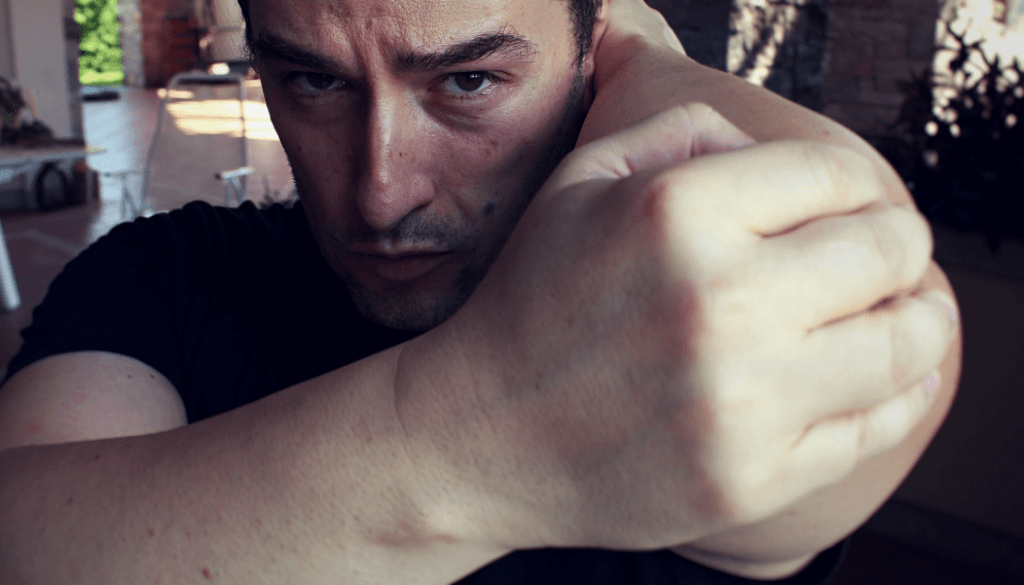Contact with the adversary: Solid interaction
Interacting with the opponent’s body in a conscious way: the Solid state contacts
6 Dragons Kung Fu has different types of combat interactions with the opponents (read The 6 Dragons Kung Fu’s states of interaction) and we call “Solid” the ones that aim to rigidly address the adversary.
Note – This article has been asked by one of our Core Course practitioners on Patreon (see how to attend our home study classes here Learn Kung Fu online: a beginner-to-expert course).
This kind of contacts:
- Are the most instinctive, “I’m in danger, I stiffen to resist and impose my strength”
- Are common to the vast majority of martial arts (Karate, Muay Thai, etc.)
- Are the less preferable in terms of effectiveness but a good fighter cannot avoid mastering them
- Are powerful but slow, they require a lot of energy and deep conditioning, both in terms of impact resistance (read Conditioning check for the impact) and pure muscle development
- As the other states, can be extended to the entire body (relatively rare) or (more frequently) limited to a single element
- To simplify, are based on the fact of tightening as much as possible the muscles in the various phases of a specific activity
- Are, if used outside a tactical choice, extremely counterproductive (typical of the not-practitioners and beginners)
- …
The Solid state of interaction: characteristics and samples
Let’s now see how and where Solid states can be implemented through some practical examples.
Hitting and tackle:
- Striking (kicking, punching, elbowing, shouldering, etc.)
- Scratching / biting (tear, cause abrasions, etc.)
- Stimulate pressure points (pain areas, pressure points, etc.)
- Parrying (either directly, such as simple displacement, etc.)
- Opposing force against force (eg. a strong / conditioned part against a weak part)
- Absorbing the opposing force (eg. a strong / conditioned part against a strength)
- …
Lock and subdue:
- Hold / immobilize the opponent (submissions, constrictions, etc.)
- Various joint locks (Chin Na, etc.)
- …
Push and Pull:
- Projecting our strength on the opponent (throws, etc.)
- Engage the opponent between two forces (eg. knee and elbow)
- Drag / yank the opponent (eg. to unbalance)
- …
Final notes
A few conclusive thoughts:
- Some of the cited interactions are not too favorable and should be used only in the case where other methods forcibly lack effectiveness; at the same time, we still have to take them into consideration because they represent a further and sometimes more effective fighting tool (an ulterior chance to prevail)
- For example, a basic rigid parry (the one that absorbs much of the impact of the opponent’s attack) on one side forces us to endure pain or slight damage but on the other can save us from more negative outcomes (severe damage, guard opening, etc.)
- In this discussion, we mentioned specific types of combat activities to exemplify solid interactions but it should be pointed out that most of the fighting techniques of our combat system can be carried as Solid, as Liquid as Fluid; it is important to understand that, in the economy of a fight, each move is closely related to those that precede and those that follow it (if not consequential or simultaneous); every action should be adapted to the context in which is performed (in terms of state, speed, direction, power, strategic value, etc.)
- …
Many martial arts stop to the solid aspect of the fight, in 6 Dragons Kung Fu, we try instead to go further annexing even liquid and fluid interactions (sometimes more favorable but more difficult to apply): in the next article of this series, we will see them (read The 6DKF’s Liquid and Fluid Contacts).
In-depth video courses
- Structures for combat: liquid, solid, fluid – A video course that extendedly explains the 6 Dragons Kung Fu’s states of interaction
- Basic 6 Dragons Kung Fu Exercises – All the fundamental practices to build real martial skills
- Advanced speed and reflexes training – How to improve combat speed day by day, from immediate improvements to the deep training
In-depth articles
- Physical conditioning: how it works – The general conditioning path for combat purpose
- Trapping – At the base of an advanced implementation of states of interaction
Questions
Reply in the comments and share your experience:
- What is your natural reaction to a situation of danger?
Author: Master Kongling
Founder of 6 Dragons Kung Fu.How to master 6 Dragons Kung Fu?
Are you searching for:
- Daily training exercises?
- Synthetic theory and concepts?
- A step by step path from white to black belt?
- A path (clear, consequential and gradual) designed to build real martial skills?
- A direct contact with Master Kongling?
Go to our Patreon page and choose a training plan: starting from the Practitioner level, you will gain access to all this and much more.
Inside each Premium Lesson, you will receive the same teaching (practices, tips, concepts, small secrets and corrections) reserved to the live students of Master Kongling.
Important - Once a certain number of registrations are reached, no other participants can be accepted. For more information write to: [email protected].










August 27, 2023 @ 2:18 am
My natural reaction was to close myself
September 4, 2023 @ 12:05 pm
The instinctive reactions can be slightly modified to become more tactical but now, as an intermediate-level practitioner, you overcome this level.